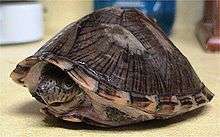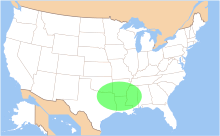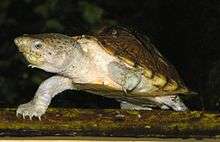Razor-backed musk turtle
| Razor-backed musk turtle | |
|---|---|
 | |
| Sternotherus carinatus | |
| Scientific classification | |
| Kingdom: | Animalia |
| Phylum: | Chordata |
| Subphylum: | Vertebrata |
| Class: | Reptilia |
| Order: | Testudines |
| Family: | Kinosternidae |
| Subfamily: | Kinosterninae |
| Genus: | Sternotherus |
| Species: | S. carinatus |
| Binomial name | |
| Sternotherus carinatus (Gray, 1856) | |
 | |
| Synonyms[1] | |
| |
The razor-backed musk turtle (Sternotherus carinatus) is a species of turtles native to the southern United States. No subspecies are recognized.[2]
Geographic range
It is found in the states of Oklahoma, Arkansas, Mississippi, Texas, Florida and Louisiana.
Description

The razor-backed musk turtle grows to about 15 cm (5.9 in) in carapace length. It has a brown-colored shell, with black markings at the edges of each scute. The shell has a distinct, sharp keel down the center of its length, giving the species its common name. The body is typically grey-brown in color, with black spotting, as is the head, which tends to have a bulbous shape to it. It has a long neck, short legs, and a sharp beak. Males can usually be distinguished from females by their longer tails.
The plastron is small, with only one hinge which is located anteriorly. There is no gular scute. Barbels are present on the chin only.[3]
Behavior
They are almost entirely aquatic, spending most of their time in shallow, heavily vegetated, slow-moving creeks, ponds, streams, and swamps.[4] The only time they typically venture onto land is when females lay their eggs. However, both sexes bask often.
Diet
Their diets consist primarily of aquatic invertebrates, including freshwater clams, crayfish, snails, and various insects. They also feed on fish and carrion.
In captivity
The razor-backed musk turtle is frequently kept in captivity, and is regularly captive bred. Its relatively small size, and ease of care makes it a more attractive choice as a pet turtle for many keepers, than the more commonly available red-eared slider (Trachemys scripta elegans).
References
- ↑ Fritz, Uwe; Havaš, Peter (2007). "Checklist of Chelonians of the World". Vertebrate Zoology. 57 (2): 262. ISSN 1864-5755. Archived from the original (PDF) on 2010-12-17. Retrieved 29 May 2012.
- ↑ The Reptile Database. www.reptile-database.org
- ↑ Conant R. 1975. A Field Guide to Reptiles and Amphibians of Eastern and Central North America, Second Edition. Boston: Houghton Mifflin. 429 pp. ISBN 0-395-19977-8. (Sternotherus carinatus, pp. 41, 46 (Fig. 7) + Plate 4 + Map 9).
- ↑ Smith HM, Brodie ED Jr. 1982. Reptiles of North America: A Guide to Field Identification. New York: Golden Press. 240 pp. ISBN 0-307-13666-3. (Sternotherus carinatus, pp. 28-29).
| Wikimedia Commons has media related to Sternotherus carinatus. |
| Wikispecies has information related to: Sternotherus carinatus |
Further reading
- Gray JE. 1856. On some New Species of Freshwater Tortoises from North America, Ceylon and Australia. Ann. Mag. Nat. Hist., Series 2, 18: 263-268. (Aromochelys carinata, new species, p. 266).